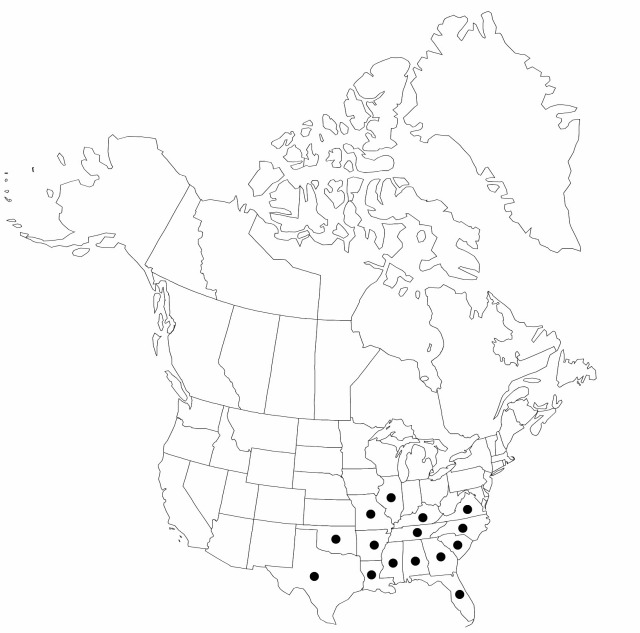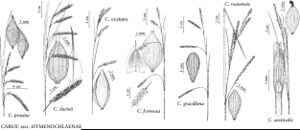Difference between revisions of "Carex oxylepis"
Ann. Lyceum Nat. Hist. New York 3: 409. 1836.
FNA>Volume Importer |
FNA>Volume Importer |
||
| Line 12: | Line 12: | ||
|name=Carex oxylepis var. pubescens | |name=Carex oxylepis var. pubescens | ||
|authority=J. K. Underwood | |authority=J. K. Underwood | ||
| + | |rank=variety | ||
}} | }} | ||
|hierarchy=Cyperaceae;Carex;Carex sect. Hymenochlaenae;Carex oxylepis | |hierarchy=Cyperaceae;Carex;Carex sect. Hymenochlaenae;Carex oxylepis | ||
| Line 26: | Line 27: | ||
|habitat=Floodplain forests, rich, moist deciduous forests, near streams or in swampy areas, upland forests on sandy soils, wooded bluffs, often associated with calcareous soils | |habitat=Floodplain forests, rich, moist deciduous forests, near streams or in swampy areas, upland forests on sandy soils, wooded bluffs, often associated with calcareous soils | ||
|distribution=Ala.;Ark.;Fla.;Ga.;Ill.;Ky.;La.;Miss.;Mo.;N.C.;Okla.;S.C.;Tenn.;Tex.;Va. | |distribution=Ala.;Ark.;Fla.;Ga.;Ill.;Ky.;La.;Miss.;Mo.;N.C.;Okla.;S.C.;Tenn.;Tex.;Va. | ||
| − | |discussion=<p>Plants with glabrous leaves and sheaths are occasionally found and have been treated as <i>Carex oxylepis</i> forma glabra Kükenthal; plants with perigynia pubescent, in addition to normally pilose leaves and sheaths, have been treated as <i>C. oxylepis</i> < | + | |discussion=<p>Plants with glabrous leaves and sheaths are occasionally found and have been treated as <i>Carex oxylepis</i> forma glabra Kükenthal; plants with perigynia pubescent, in addition to normally pilose leaves and sheaths, have been treated as <i>C. oxylepis</i> <i></i>var.<i> pubescens</i>. Taxonomic recognition is not warranted in either case because the traits vary within populations and are not correlated with other structural differences.</p> |
|tables= | |tables= | ||
|references= | |references= | ||
| Line 35: | Line 36: | ||
-->{{#Taxon: | -->{{#Taxon: | ||
name=Carex oxylepis | name=Carex oxylepis | ||
| − | |||
|authority=Torrey & Hooker | |authority=Torrey & Hooker | ||
|rank=species | |rank=species | ||
| Line 49: | Line 49: | ||
|publication year=1836 | |publication year=1836 | ||
|special status= | |special status= | ||
| − | |source xml=https://jpend@bitbucket.org/aafc-mbb/fna-data-curation.git/src/ | + | |source xml=https://jpend@bitbucket.org/aafc-mbb/fna-data-curation.git/src/f50eec43f223ca0e34566be0b046453a0960e173/coarse_grained_fna_xml/V23/V23_851.xml |
|genus=Carex | |genus=Carex | ||
|section=Carex sect. Hymenochlaenae | |section=Carex sect. Hymenochlaenae | ||
Revision as of 20:12, 16 December 2019
Plants densely cespitose. Culms dark maroon at base; flowering stems 25–80 cm, usually longer than leaves at maturity, 1–2 mm thick, glabous to pubescent. Leaves: basal sheaths maroon, bladeless, pubescent, sometimes glabrous, others grading from maroon to green on back, light brown-hyaline on front, dotted or streaked with dark red, pubescent distally; blades flat, 3–7 mm wide, pilose, especially abaxially, sparsely so distally, margins ciliate. Inflorescences: peduncles of lateral spikes slender, 5–20 mm, shorter than spikes, pubescent; peduncle of terminal spikes 5–40 mm, minutely scabrous; proximal bracts nearly equaling but usually not exceeding inflorescences; sheaths 15–25 mm; blades 1.5–3 mm wide. Lateral spikes 2–4, 1 per node, distal 2 usually overlapping terminal spike, others well separated, nodding or drooping at maturity, pistillate with 20–45 perigynia attached 1.5 mm apart, narrowly cylindric, 15–45 × 3–4.5 mm. Terminal spike gynecandrous, 15–45 × 2–4.5 mm. Pistillate scales hyaline with broad green, red dotted midrib, elliptic-ovate, shorter than mature perigynia, apex acute to aristate or awned, awn less than 1 mm, ciliate. Perigynia green to dark olive-green, copiously red dotted, 2-ribbed with 6–10 almost equally prominent veins, loosely enveloping achenes, ellipsoid-ovoid, 3.5–5 × 1.7–2 mm, membranous, base acute or with short stipe, apex gradually tapered to beak, glabrous or less often pubescent; beak minutely bidentate, 0.4–0.7 mm. Achenes distinctly stipitate, 1.7–2.5 × 1–1.5 mm, stipe to 0.7 mm.
Phenology: Fruiting late spring–early summer.
Habitat: Floodplain forests, rich, moist deciduous forests, near streams or in swampy areas, upland forests on sandy soils, wooded bluffs, often associated with calcareous soils
Distribution

Ala., Ark., Fla., Ga., Ill., Ky., La., Miss., Mo., N.C., Okla., S.C., Tenn., Tex., Va.
Discussion
Plants with glabrous leaves and sheaths are occasionally found and have been treated as Carex oxylepis forma glabra Kükenthal; plants with perigynia pubescent, in addition to normally pilose leaves and sheaths, have been treated as C. oxylepis var. pubescens. Taxonomic recognition is not warranted in either case because the traits vary within populations and are not correlated with other structural differences.
Selected References
None.
